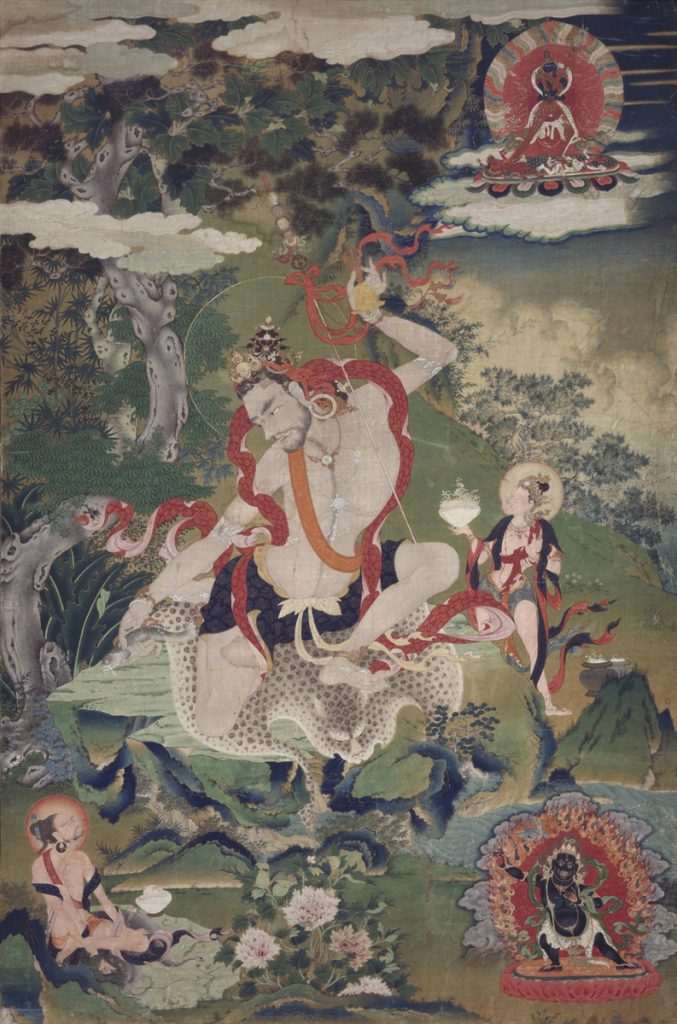Mahamudra, or “great seal,” is a term used in Vajrayana Buddhism to refer to the mark, or nature, of all experience: emptiness. Mahamudra practice is most commonly associated with the Kagyü tradition of Tibet. What follows is taken from Ken McLeod’s “The Way of Freedom,” a Tricycle Online Retreat.
For instance, consider space: what depends on what?
—Tilopa, Pith Instructions on Mahamudra (trans. Ken McLeod)
“Space” is a metaphor for mahamudra. We say “mahamudra,” but we could also say nature of mind, nature of experience, ultimate reality, perfection of wisdom, original purity, totality of experience — there are a lot of names here. You can easily come up with at least twenty in just the Tibetan tradition.
What all of these names are pointing to is a way of experiencing the world, experiencing our lives, experiencing ourselves, that is free of struggle. It can be called freedom, or nirvana, and a lot of other things. Over and over again, people make it into a thing, reality, ultimate truth, whatever, but in the end, it is just a way of experiencing life. Ironically, even though so much has been written about this way of experiencing life, we have no way of knowing whether it’s the same experience for everybody. The important point is that each of us has the possibility of finding a way to experience our lives free of struggle. And one of the common features of all these different ways is a sense of extraordinary openness and groundlessness, which in Buddhism is often referred to as emptiness.
People who find this experience of freedom, or, more accurately, find their own way of experiencing freedom, almost always talk about this emptiness aspect.
Related: The Vajrayana Journey Is an Experience of Love, Power and Freedom.
I mention this explicitly because the term mahamudra points to this emptiness. Mahamudra is composed of two Sanskrit words, maha and mudra. Maha is easy to translate: it means “great,” or “big.” Mudra has a lot of different meanings: sign, symbol, gesture, seal, and so on. In this context, it is usually taken to mean “seal,” like the seal that you would use with sealing wax, a personal seal that marks what belongs to you. Mahamudra, then, means “great seal,” great because it is a seal that marks all of experience.
What is it that stamps all of experience? What feature does all experience have in common? All experience is groundless, open, empty.
You can say, “Well, this floor doesn’t feel empty,” and you are right. It feels very solid. But emptiness refers to a way of experiencing things. And when you experience things this way, it is such a powerful experience that you almost always come out of it saying, “Oh! This is how things really are, this is reality.” Even so, we can’t get away from the fact that it is a way of experiencing things.
One of the things we have to pay careful attention to is that in the English and American traditions of philosophy, we are used to thinking in terms of ontology, that is, whether things exist or not, whereas Buddhist thought is almost always based on epistemology, that is, how do we experience things?
You may remember Bill Clinton’s famous phrase from the Monica Lewinsky scandal, “It all depends on what the meaning of ‘is’ is.” Well, his little witticism actually applies here, although I’m going to interpret it differently from the way he probably meant it. “Is” can mean something exists, which is normally how we think of it. “Is” can also mean, “This is how I experience it.” The latter usage applies here. In other words when we say, “Things are empty,” or “Experience is empty,” we’re referring to a way of experiencing life that is very powerful and transformative. It changes the way we relate to everything. It has a real effect in the world. The ontological question—that is, does something exist or not—is not particularly helpful, and we won’t spend any time on that. Tilopa, the early Indian founder of the practice, teaches Mahamudra by considering different aspects of the metaphor of space.
The first one is about dependence. On what does space depend, and what depends on space? Now, to move this discussion into the practice arena, when you pose that question, what happens in you? What do you experience when you consider that question? That is our starting point.
♦
To participate in Ken McLeod’s online retreat, click here and become a Tricycle Sustaining Member.
Image: Tilopa, an 11th century Indian master of esoteric Buddhism, is a key figure in the mahamudra lineages of the Tibetan tradition. He represents an approach to practice that embraces the totality of the human condition, with all its challenges and contradictions, rather than the pursuit of idealistic purity. Working as a grinder of sesame seeds by day and a procurer of clients for a prostitute by night, he cultivated an experience of wakefulness that didn’t depend on external conditions. His Mahamudra in Six Lines captures the essence of this practice: don’t recall, don’t imagine, don’t think, don’t examine, don’t control, rest.
Thank you for subscribing to Tricycle! As a nonprofit, we depend on readers like you to keep Buddhist teachings and practices widely available.
